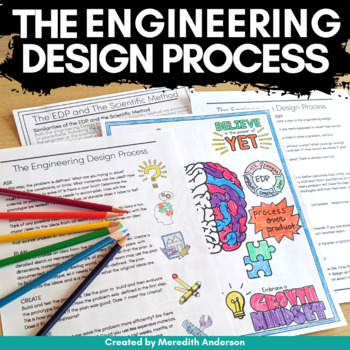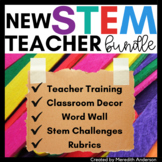Engineering Design Process Worksheets, Activities, and Rubrics
- PDF
What educators are saying
Also included in
- SAVE OVER 70% FOR A LIMITED TIME! 60 low prep STEM challenges PLUS everything you need to teach the Engineering Design Process! These activities are the perfect way to explore science concepts like sound, force and motion, aerodynamics, and more! Students will also find connections to STEM careers aPrice $37.00Original Price $153.50Save $116.50
- This download contains a bundle of resources focused on the engineering design process! Get started with the EDP, then try a digital breakout (2 options included - one for elementary and one for upper grades)! I have also included a digital STEM journal for students to record their process (plus a pPrice $17.00Original Price $26.00Save $9.00
- Are you a new STEM teacher? This resource will give you the background training you need to:Understand and utilize the engineering design process (EDP) with teacher training ebookSet up your classroom (posters and word wall)Vet STEM challenges and evaluate student work (checklist and rubrics)ProvidePrice $44.00Original Price $58.00Save $14.00
Description
STEM without the Engineering Design Process is like making a pizza without the crust. I mean, why even bother? STEM challenges *need* a solid foundation to provide the best learning experience and growth opportunities for your students. The EDP is the foundational process that should be guiding ALL your STEM activities.
If you are new to teaching STEM or the engineering design process, this resource has everything you need to understand the EDP and how to implement it with your students. If you a seasoned STEM educator, the teacher guide will serve as a refresher for you, and the printables and activities will help reinforce STEM learning with your students.
✅ What You'll Get ✅
This resource is the culmination of years of my work as an engineer and STEM educator! In it, you will find:
- ✅ A 20+ page teacher guide:
- A brief overview of STEM and why it's important
- An in-depth look at each step of the EDP
- The 4 Cs and STEM
- The Scientific Method and comparison to the EDP
- A simplified and fun acronym option for teaching the EDP to younger students
- How to tell if it's STEM (Is it Impostor STEM or ✨ Authentic ✨ STEM?)
- Video links to introduce the EDP
- STEM challenge tips
- Walk-through for Index Card STEM challenge
- Completed samples
- Follow-up questions to ask students to assess STEM learning and encourage out-of-the-box thinking
- ✅ Student Printables
- 3-page introduction to the EDP
- EDP warm up activity (2 levels provided)
- Research an engineering profession
- EDP printable (students label and define steps)
- Scientific method overview and EDP comparison (3 pages)
- EDP and Scientific Method sorting activity
- EDP knowledge check/assessment (2 options)
- Growth mindset and failure color and doodle page (2 options)
- ✅ Bonuses
- Checklists and Rubrics: 6 pre-made checklists and rubrics plus 3 editable options (in Google Slides)
- EDP Posters: Choose from "Ask Imagine Plan Create Improve" or DIP ME "Define Imagine Plan Make Enhance" (If you attended Elementary STEM Con, you may remember Dip Me!)
- Graphic Organizers and STEM Challenge Recording Sheet: Several options to choose from for students to record their ideas, data, and progress.
- Spot Impostor STEM! Can you tell the difference between a high-quality, authentic STEM challenge and an impostor? Use the graphic and checklist to vet STEM challenges you want to try in your classroom.








